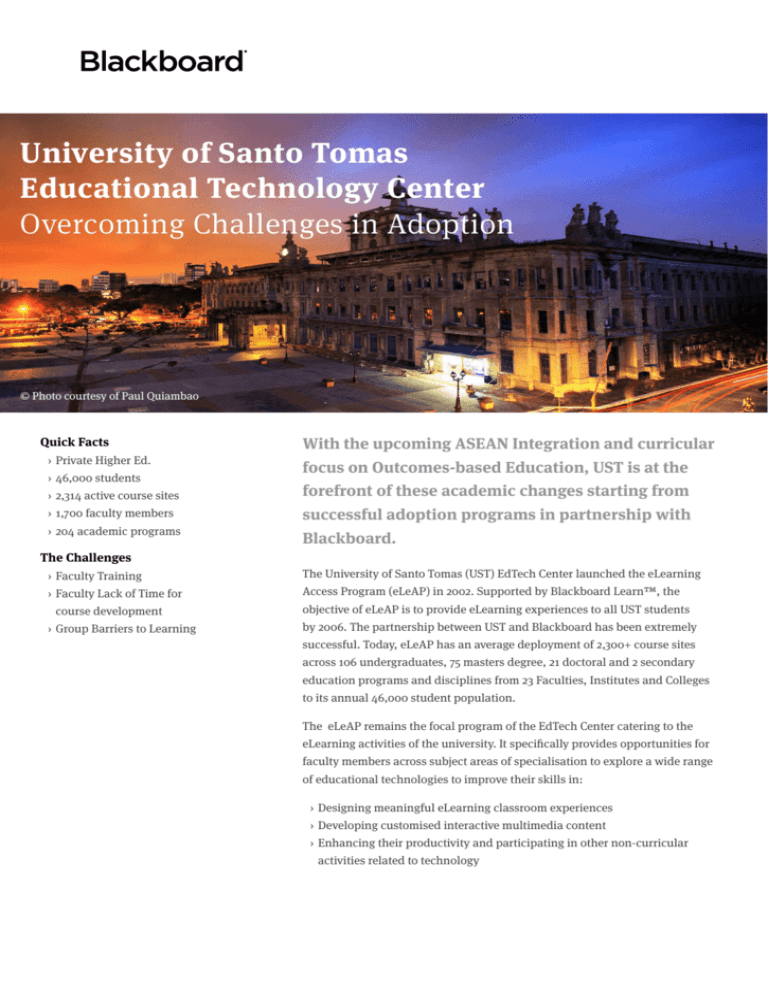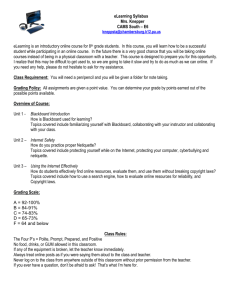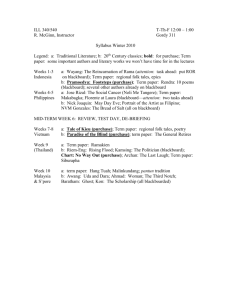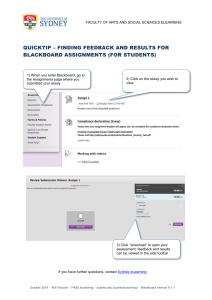
University of Santo Tomas
Educational Technology Center
Overcoming Challenges in Adoption
© Photo courtesy of Paul Quiambao
Quick Facts
›› Private Higher Ed.
›› 46,000 students
With the upcoming ASEAN Integration and curricular
focus on Outcomes-based Education, UST is at the
›› 2,314 active course sites
forefront of these academic changes starting from
›› 1,700 faculty members
successful adoption programs in partnership with
›› 204 academic programs
Blackboard.
The Challenges
›› Faculty Training
The University of Santo Tomas (UST) EdTech Center launched the eLearning
›› Faculty Lack of Time for
Access Program (eLeAP) in 2002. Supported by Blackboard Learn™, the
course development
›› Group Barriers to Learning
objective of eLeAP is to provide eLearning experiences to all UST students
by 2006. The partnership between UST and Blackboard has been extremely
successful. Today, eLeAP has an average deployment of 2,300+ course sites
across 106 undergraduates, 75 masters degree, 21 doctoral and 2 secondary
education programs and disciplines from 23 Faculties, Institutes and Colleges
to its annual 46,000 student population.
The eLeAP remains the focal program of the EdTech Center catering to the
eLearning activities of the university. It specifically provides opportunities for
faculty members across subject areas of specialisation to explore a wide range
of educational technologies to improve their skills in:
›› Designing meaningful eLearning classroom experiences
›› Developing customised interactive multimedia content
›› Enhancing their productivity and participating in other non-curricular
activities related to technology
Interesting Fact #1
University of Santo Tomas is
the oldest existing university
in Asia.
Overcoming Adoption Challenges
The Challenges
1. Faculty Training for the Development of eLearning Competency
One of the challenges faced by UST was faculty training. Every new
faculty member must be trained on a regular basis as they are added to
a current pool of instructors. Current faculty members are consistently
mentored by UST EdTech Center’s coordinators for the professional
development and encouragement of faculty members’ use of teaching
and learning technology, and for the continuing support of good practice.
2. Supporting Educators Efficiencies
Due to the number of teaching assignments, faculty members find it hard
to dedicate time for course development. As there were varying areas
of specialisations such as Music or Physical Education, some faculty
members found it hard to integrate eLearning into their syllabus. Personal
characteristics such as age, culture or experience with the computer for
educational purpose and attitude towards eLearning can also affect the
adoption of a technology in an institution.
Overcoming the Challenges
Robust Training Program - “The
standardisation of UST training
program on the Blackboard LMS
across colleges enabled us to
uniformly train 1,700+ faculty
members while assuring quality
of training outcomes through
evidence-based training outputs.”
Training Goals - “Goal was to
train 20% of faculty members
since 2013, but this school year,
we are already aiming for our
80% target on teaching training
while monitoring its impact to the
number of course sites requested by
the faculty per college.”
and learning. It has also further improved eLearning experiences
through UST ‘Bring Your Own Device’ movement and Flipped
Classroom framework.
Working Hand-in-Hand with Blackboard to
Achieve Institutional Goal
The partnership between UST and Blackboard has brought with it
many positive changes that has eventually impacted student learning.
Through the years, Blackboard has enabled UST’s faculty members
to design, deliver, revise and evaluate their deployed course sites
in a secure and reliable learning environment on the Blackboard
platform. Classes in the form of web-presence, web-enhanced or fully
online course sites has helped improve lesson delivery by providing
anytime anywhere online learning opportunities through teachercentered, student-centered and team-centered approaches. Through
Blackboard Learn and Mobile Learn, UST has also enriched learning
experiences of students through well-designed online activities that are
conveniently accessible.
UST standardised their training programs throughout the university,
Expanding LMS with Mobility - UST decided to use Blackboard Learn as
enabling them to uniformly conduct the capacity building across
the key platform to deliver its teaching and learning, and support eLeAP’s
1,700+ faculty members while assuring quality of training outcomes
goals with improved faculty adoption of technology in its institution. The
through evidence-based training outputs. The centralised approach
Blackboard LMS has been the foundation for a rich education experience
to both academic and technical support services to faculty members
for UST. Designed as a student-centred LMS while providing an easy-to-
allowed UST to cover the entire university through their semestral
use and time saving platform for educators, UST uses Blackboard Learn to
monitoring system of their training, mentoring and consultation
bring their classrooms online with tools to engage and collaborate. Their
services.
faculty members can deliver access to learning from virtually anywhere,
connect communities, deliver targeted information to motivate and keep
Successful Roll Out of Blackboard Learn and
learners on track, and centrally store and share content anywhere. The
Mobile Learn to Students and Faculty
ease of user experience with Blackboard Learn has enabled the UST EdTech
With the right combination of robust academic, technical and financial
Center with integrating technology into their adoption program and to
support services to facilitate 21st century digital age teaching and
improve the ICT competency across all their faculty members.
learning, UST eLearning Access Program together with Blackboard, has
In 2014, the UST EdTech Center introduced Blackboard Mobile Learn
where students can access their course materials through mobile devices
such as tablets and smart phones. With the Blackboard Mobile Learn
platform, student and faculty can take interactive teaching and learning
mobile, giving them access to their courses, content and organisations
on a variety of devices including iOS® and Android™ smartphones for a
Faithful to her centuries-old
tradition of excellence, the
University of Santo Tomas
will continue to expand and
transform its online learning
environment for its students
and facultymembers,
and work towards
being globallyrecognised as an
institution of higher
learning.
celebrated over 10 years of successful implementation of institutionwide eLearning, from high school to graduate school levels. Faithful to
her centuries-old tradition of excellence, the University of Santo Tomas
will continue to expand and transform its online learning environment
for its students and faculty members, and work towards being globallyrecognised as an institution of higher learning.
mobile LMS experience. Students and faculty can access the discussion
boards, students can find out their grades on Grades tool, receive instant
announcements, access content uploaded by faculty members and take
tests on the Blackboard Mobile Learn platform. The mobile platform has
helped with integrating technology with ease into the delivery of teaching
Blackboard.com
Interesting Fact #2
With 46,000 students, UST has the
largest student population in a single
campus in the world, for a catholic
university.
How UST Faculty Members Use Blackboard
Learn and Mobile Learn
Arnold Josue, Convervatory of Music - Arnold uses Blackboard Learn
to create online music assignments, share music and videos without
limitation. He also uses Mobile Learn to record live rehearsals and likes
the accesibility and user-friendliness of both solutions.
Did you know?
Marie Christy Iguid, UST High School Department - Marie uses
UST hosted the Pope’s visit to the
Mobile Learn to disseminate motivational materials and information
Philippines in January 2o15, and
and share thoughts on certain topics with her students. She thinks that
trained over 5,000 volunteers on the
Mobile Learn motivates the technology-savvy students of today.
Blackboard platform.
Dr. Noel Martin Bautista, Faculty of Medicine and Surgery - Dr.
Noel likes how important announcements like change of schedules and
online viewing of grades can be rapidly disseminated via Blackboard
Learn and Mobile Learn. He collects feedback via the platform, shares
study materials and likes how it provides for rapid and easy checking
against plagiarism.
Al Denn John Lozada, Institute of Physical Education and Athletics
(IPEA) - Apart from using the discussion board and generating online
quizzes on Blackboard Learn, Al Denn also likes the quick and easy
access in watching video clips of certain drills in sports. He also
organizes supplementary classroom meetings during holidays for his
students via Blackboard Learn.
Wilberto A. Lumaban, Institute of Religion - Wilberto uses
Blackboard Learn for assigning follow-up activities to his students
and likes the Grade Center for monitoring of his students’ progress.
He enjoys paperless learning and finds it convenient that checking his
students’ grades is just a click away.
“Sustaining massive-wide, successful implementation
of eLearning requires a full-scale spectrum of tactics in the
continuous adoption and adaptation of the entire academic
community.”
A/Prof Anna Cherylle M. Ramos
Director of Educational Technology Center, University of Santo Tomas
Blackboard.com
Copyright © 2015. Blackboard Inc. All rights reserved. Blackboard, the Blackboard logo, BbWorld, Blackboard Learn, Blackboard Transact, Blackboard Connect, Blackboard Mobile,
Blackboard Collaborate, Blackboard Analytics, Blackboard Engage, Edline, the Edline logo, the Blackboard Outcomes System, Behind the Blackboard, and Connect-ED are trademarks or
registered trademarks of Blackboard Inc. or its subsidiaries in the United States and/or other countries. Blackboard products and services may be covered by one or more of the following
U.S. Patents: 8,265,968, 7,493,396; 7,558,853; 6,816,878; 8,150,925




